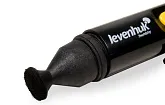Guide to Binoculars
Numbers
You might have noticed that the names of binoculars always include numbers, such as Levenhuk Karma PLUS 8x25 Binoculars. If you are a beginner, you might not know what those number mean. The first number, 10 in our example, is the magnification. In other words, a magnification of 10 will make the object appear 10 times closer to you or 10 times larger than you would see it with the naked eye.
Note that a magnification of 10 is probably all you would need for regular purposes. As the number increases, the image becomes more blurred and shaky and less bright. This happens because, along with the object, everything else is magnified, including the tremble in your hands. If magnification is higher than 10, you should use support for the binoculars, such as a tripod.
The second number, 40 in our example, indicates the diameter of the front lens. The higher the number, the better it is for the image. So, 10x40 is much more comfortable than 10x25, for example. The only disadvantage of the higher number is that it increases the weight of the binoculars.
Field of view
Field of view is another thing to keep in mind when you are deciding which binoculars to buy. In short, field of view refers to the amount of space you see through the binoculars. Suppose you have a wall 1000 yards ahead of you. With the field of view 250 you will see 250 feet of that wall without having to turn your head. Logically, as the magnification increases, you will see less of that wall, but in greater detail. Therefore, the higher the magnification, the smaller the field of view.
If you wear glasses, you have to consider the eye relief of the binoculars. The eye relief is the maximum distance from the eye to the eyepiece at which the entire field of view is still observable. This distance shouldn't be smaller than the thickness of your glasses.
Exit pupil
Think of the exit pupil as the pupil of your eye on your binocular lens. It is calculated in millimeters by dividing the second number by the first, like this: 40/10=4. The exit pupil roughly tells you what the brightness of the image will be. For basic purposes 2.5-3 is just fine. For stargazing, 5-7 is better. Anything higher is not necessary, except for situations in which the binoculars shake heavily, such as on the boat; 7+ gives a steadier image than any other exit pupil.
Prisms
A prism is a piece of glass that flips the image from its upside-down position as it comes through the front lens so that we see it properly. Prisms are an absolute necessity.
There are porro prisms and roof prisms. The difference is clear. Porro prisms are classical: the light travels through several prisms located at various levels inside the binoculars and into the eye. Such construction makes the binoculars heavier and bulkier - also less expensive and of very high quality.
The roof prisms make the binoculars look and feel light. So, if you see two connected straight tubes, rest assured that inside these binoculars is a roof prism. The weight and looks are probably the only advantages of this prism over the roof prism, the disadvantages being a much higher price and a less sharp image.
The glass used in prisms determines their quality. There are two types: Bak4 (very high quality) and BK7 (not as good).
Lens coating
When light travels through the lens, it loses much of its brilliance. So, to keep the image bright, special chemicals are used. The lenses may have only one layer of coating (least effective). Multicoating is much better, covering the lenses with several layers of the special chemicals and making the image much brighter. Full multicoating is best, with every single lens in the binoculars multicoated.
Focus
When you look through binoculars, the image is not always sharp right away - the focus has to be adjusted. There are three common type of focusing. Center focus binoculars have a weal in the middle, which, when rotated, adjusts the focus for both eyes simultaneously. This is the most common construction. Individual eyepiece focus demands separate adjustment for each eyepiece, but once focused, it doesn't have to be adjusted ever again because it is adapted to your eyesight. This is very good for long distances but not so good for short distances. In some budget models, the focus is fixed by the manufacturer and you cannot adjust it, which is not ideal.
The center focus binoculars and individual eyepiece binoculars usually also allow you to adjust the diopter, which is very handy because human eyes tend to vary in vision capability.
Also, with most binoculars, you can adjust the interpupillary distance, or the distance between your pupils, by sliding the binoculars together or apart.
Each model has a minimum focus, or close focus, which refers to the distance at which the binoculars start focusing. If the object is any closer than this point, focusing becomes impossible.
Any reproduction of the material for public publication in any information medium and in any format is prohibited. You can refer to this article with active link to eu.levenhuk.com.
The manufacturer reserves the right to make changes to the pricing, product range and specifications or discontinue products without prior notice.



